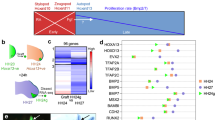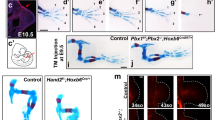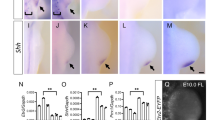Abstract
FORMATION of the vertebrate limb requires specification of cell position along three axes1. Proximal–distal identity is regulated by the apical ectodermal ridge (AER) at the distal tip of the growing limb2–6. Anterior–posterior identity is controlled by signals from the zone of polarizing activity (ZPA) within the posterior limb mesenchyme7–9. Dorsal–ventral identity is regulated by ectoderm-ally derived signals10–14. Recent studies have begun to identify signalling molecules that may mediate these patterning activities. Members of the fibroblast growth factor (FGF) family are expressed in the AER and can mimic its proximal–distal signalling activity15,16. Similarly, the gene Sonic hedgehog (Shh) is expressed in the ZPA, and Shh-expressing cells, like ZPA cells, can cause digit duplications when transplanted to the anterior limb margin17,18. In contrast, no signal has yet been identified for the dorsal–ventral axis, although Wnt-la is expressed in the dorsal ectoderm, suggesting that it may play such a role19,20. To test this possibility, we have generated mice lacking Wnt-la. activity. The limb mesoderm of these mice shows dorsal-to-ventral transformations of cell fate, indicating that Wnt-la is a dorsalizing signal. Many mutant mice also lack posterior digits, demonstrating that Wnt-la is also required for anterior–posterior patterning. We propose that normal limb development requires interactions between the signalling systems for these two axes.
This is a preview of subscription content, access via your institution
Access options
Subscribe to this journal
Receive 51 print issues and online access
$199.00 per year
only $3.90 per issue
Buy this article
- Purchase on SpringerLink
- Instant access to full article PDF
Prices may be subject to local taxes which are calculated during checkout
Similar content being viewed by others
References
Tabin, C. J. Cell 66, 199–217 (1991).
Summerbell, D., Lewis, J. H. & Wolpert, L. Nature 244, 492–496 (1973).
Saunders, J. W. J. exp. Zool. 108, 363–403 (1948).
Summerbell, D. J. Embryol. exp. Morph. 32, 651–660 (1974).
Globus, M. & Vethamany-Globus, S. Differentiation 6, 91–96 (1976).
Reiter, R. S. & Solursh, M. Devl Biol. 93, 28–35 (1982).
Saunders, J. W. & Gasseling, M. T. in Epithelial-Mesenchymal Interactions (eds Fleisch majer, R. & Billingham, R. E.) 78–97 (Williams and Wilkins, Baltimore, 1968).
Tickle, C., Summerbell, D. & Wolpert, L. Nature 254, 199–202 (1975).
Tickle, C. Nature 289, 295–298 (1981).
Finch, R. & Zwilling, E. J. exp. Zool. 176, 397–408 (1971).
MacCabe, J. A., Errick, J. & Saunders, J. W. Devl Biol. 39, 69–82 (1974).
Stark, R. J. & Searls, R. L. Devl Biol. 38, 51–63 (1974).
Geduspan, J. S. & MacCabe, J. A. Devl Biol. 124, 398–408 (1987).
Geduspan, J. S. & MacCabe, J. A. Anat. Rec. 224, 79–87 (1989).
Niswander, L., Tickle, C., Vogel, A., Booth, I. & Martin, G. R. Cell 75, 579–587 (1993).
Fallon, J. F. et al. Science 264, 104–107 (1994).
Echelard, Y. et al. Cell 75, 1417–1430 (1993).
Riddle, R. D., Johnson, R. L., Laufer, E. & Tabin, C. Cell 75, 1401–1416 (1993).
Parr, B. A., Shea, M. J., Vassileva, G. & McMahon, A. P. Development 119, 247–261 (1993).
Dealy, C. N., Roth, A., Ferrari, D., Brown, A. M. C. & Kosher, R. A. Mech. Dev. 43, 175–186 (1993).
Lyons, K. M., Pelton, R. W. & Hogan, B. L. M. Development 109, 833–844 (1990).
Davis, C. A., Holmyard, D. P., Millen, K. J. & Joyner, A. L. Development 111, 287–298 (1991).
Bulfone, A. et al. Mech. Dev. 40, 129–140 (1993).
Smith, J. C., Tickle, C. & Wolpert, L. Nature 272, 612–613 (1978).
Lee, J. J. et al. Science 266, 1528–1537 (1994).
Anderson, R., Landry, M. & Muneoka, K. Development 117, 1421–1433 (1993).
Vogel, A. & Tickle, C. Development 119, 199–206 (1993).
Niswander, L., Jeffrey, S., Martin, G. R. & Tickle, C. Nature 371, 609–612 (1994).
Laufer, E., Nelson, C. E., Johnson, R. L., Morgan, B. A. & Tabin, C. Cell 79, 993–1003 (1994).
Yang, Y. & Niswander, L. Cell (in the press).
Swiatek, P. J. & Gridley, T. Genes Dev. 7, 2071–2084 (1993).
Author information
Authors and Affiliations
Rights and permissions
About this article
Cite this article
Parr, B., McMahon, A. Dorsalizing signal Wnt-7a required for normal polarity of D–V and A–P axes of mouse limb. Nature 374, 350–353 (1995). https://doi.org/10.1038/374350a0
Received:
Accepted:
Issue Date:
DOI: https://doi.org/10.1038/374350a0



